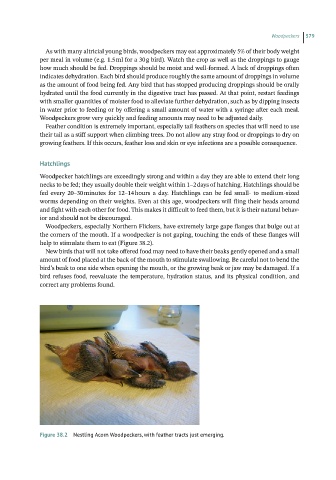Page 578 - Hand rearing birds second
P. 578
Woodpeckers 579
As with many altricial young birds, woodpeckers may eat approximately 5% of their body weight
per meal in volume (e.g. 1.5 ml for a 30 g bird). Watch the crop as well as the droppings to gauge
how much should be fed. Droppings should be moist and well‐formed. A lack of droppings often
indicates dehydration. Each bird should produce roughly the same amount of droppings in volume
as the amount of food being fed. Any bird that has stopped producing droppings should be orally
hydrated until the food currently in the digestive tract has passed. At that point, restart feedings
with smaller quantities of moister food to alleviate further dehydration, such as by dipping insects
in water prior to feeding or by offering a small amount of water with a syringe after each meal.
Woodpeckers grow very quickly and feeding amounts may need to be adjusted daily.
Feather condition is extremely important, especially tail feathers on species that will need to use
their tail as a stiff support when climbing trees. Do not allow any stray food or droppings to dry on
growing feathers. If this occurs, feather loss and skin or eye infections are a possible consequence.
Hatchlings
Woodpecker hatchlings are exceedingly strong and within a day they are able to extend their long
necks to be fed; they usually double their weight within 1–2 days of hatching. Hatchlings should be
fed every 20–30 minutes for 12–14 hours a day. Hatchlings can be fed small‐ to medium‐sized
worms depending on their weights. Even at this age, woodpeckers will fling their heads around
and fight with each other for food. This makes it difficult to feed them, but it is their natural behav-
ior and should not be discouraged.
Woodpeckers, especially Northern Flickers, have extremely large gape flanges that bulge out at
the corners of the mouth. If a woodpecker is not gaping, touching the ends of these flanges will
help to stimulate them to eat (Figure 38.2).
New birds that will not take offered food may need to have their beaks gently opened and a small
amount of food placed at the back of the mouth to stimulate swallowing. Be careful not to bend the
bird’s beak to one side when opening the mouth, or the growing beak or jaw may be damaged. If a
bird refuses food, reevaluate the temperature, hydration status, and its physical condition, and
correct any problems found.
Figure 38.2 Nestling Acorn Woodpeckers, with feather tracts just emerging.

